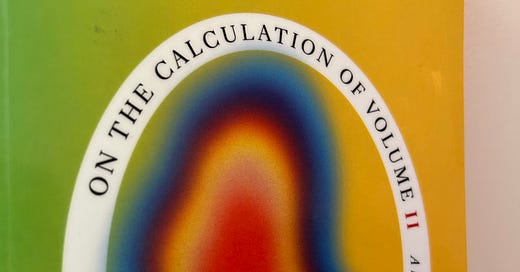On "On the Calculation of Volume," Books I & II, by Solvej Balle
The Remains of the (Groundhog) Day
On the Calculation of Volume, a series of novels by the Danish author Solvej Balle, is about a woman trapped in a time loop. Tara Selter, an antiquarian bookseller living in France, finds herself unable to move on from the 18th of November and awake unto the next day.
This is the premise of, yes, Groundhog Day, though Balle says she took inspiration from Ulysses with regards to exploring how much of a fictional world could be captured over the course of one day. (She also told the Guardian she had been thinking about the idea since the 1980s.) The novels, told in the form of Tara’s diary entries, chronicle her attempt to decipher the laws governing her new reality, and the possible ways to live within it. Book I begins on Tara’s 121st experience of November 18th.
The juxtaposition of the European modernist influence and the formulaic is what makes On the Calculation of Volume so seductive. Balle is a highbrow artist writing a time-travel series. Her prose resembles the affectless anti-style of fellow Europeans like Rachel Cusk and Karl Ove Knausgaard; like the latter, Balle pays close attention to the mundane details and repetitions of everyday life. At the same time she is, by way of her conceptual conceit, effectively writing a quest narrative, one that nods at various points in the direction of genres ranging from sci-fi to romance, while also remaining thoroughly existentialist. (Note to the Bill Murray stans out there: The one genre these books don’t touch is comedy. They are fun to read, but never funny.)
Whether Tara will ever see the 19th of November is therefore both a philosophical springboard and a plot device, and this duality enables Balle’s simple sentences to operate in multiple registers. She has taken the best aspects of the Knausgaardian mode and brilliantly re-cast them with an air of cosmic mystery. For example: Tara is married to Thomas, who is not stuck in the time loop with her. This causes Tara to eventually grow distant. “Time has come between us” she says, in what is both a cliche of love gone bad and a commentary on the quantum mechanical conundrum in which she is stuck.
Another example: As Tara moves through the world she starts to contemplate her impact on her fixed environment, because the food she eats is not replenished the next day on the store shelves: “I have become a ravening monster, a monster in a finite world,” says Tara. “How long can my little world endure me?” The intimations of climate change—Balle returns frequently to the theme of Tara’s “devouring” of the world—come through especially in the second book as Tara wanders Europe in search of seasons.
The disappearing food also gets at one nagging question about the series, which aspires to be a septology (Balle has written five volumes so far, and the third will appear in English later this year): Just how much attention is Balle paying to the plotting of the “laws” of the time loop Tara finds herself in? Food doesn’t reappear in the subsequent November 18ths, but Tara’s credit card hasn’t run short of funds after more than two years of spending; Tara’s internet searches evaporate at the start of a new day, but the paper she writes on does not.
These books are not an exercise in monumental world building—the first two are both under 200 pages—and their immense pleasure does not come from intricately imagining all the implied consequences of the premise. Balle’s primary orientation is to the sensations of the natural world, and if anything the books can seem deliberately at a remove from the technological present—cellphones aren’t mentioned, for example, until deep into book II. But the internal logic question does call to mind a predicament familiar to devotees of episodic “prestige TV.” (If the comparison seems crass, know that the second book ends on what can only be called a cliffhanger.)
Like with prestige TV shows grounded in a science-fiction-esque realm—say, Severance; or the earlier, truly baffling (both in terms of plot and popularity) Lost—as time passes (from season to season, from book to book) there can be the feeling that the “world building” may prove a lot more satisfying than the ‘world explaining.’
At this point in the septology, however, Balle has more than earned the benefit of any doubt. She is brilliantly navigating her singular form, with books that gracefully slide through big ideas—about identity, love, memory—as they go about their day.
On the Calculation of Volume, Books I & II
Author: Solvej Balle
Translated from the Danish by Barbara J. Haveland
Pages: 160; 176
Years: 2020; 2020 (2024; 2024 NDP Editions)
Genre: Fiction
OSR Tier: Emerging canon
Next: Pathemata and Bluets, by Nelson



